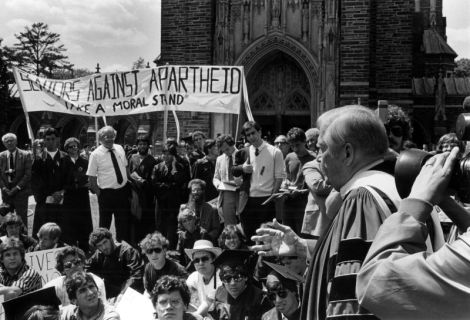Years ago, an editor of mine drifted into a nostalgic reverie when he was supposed to be telling me how to do journalism, and that is the story of how I first heard about the divestment movement of the ‘80s.
“It was fantastic,” he said. “So many protests. We wouldn’t stop, we told the college administration, until they got rid of all its investments in things like South African gold mines. We occupied buildings. Oh, I barely even went to class.” He twitched, like a man shaking off a daydream. “And the administration did get rid of its investments. Years later. When it didn’t mean anything. But still, it was great.”
At the time, I marveled at the existence of people who could sustain enthusiasm for any protest movement. I had been to exactly one demonstration: As a college student I had carpooled in an ancient Volkswagen Rabbit to Washington, D.C., for the inauguration of George W. Bush Jr. I was shy and scared of crowds, but I felt possessed with the injustice of the election. I had just taken a history class about the ‘60s, and from what I could gather, this is what Americans did when they were disappointed in their government.
It was the first time I had been to the capital. The sky was the color of pewter and it was raining ice. I remember standing there, surrounded by a seemingly inconceivable number of decent American folk from all walks of life. “Well this is it,” I thought. “Now that so many people are here to register their disapproval, things are really going to change.”
Instead, we stood, facing the police lining the route of the presidential motorcade, until we were all coated with a delicate rime of ice, like frosted donuts. After about a thousand years, a parade of limos drove by, and a hand waved out the back window of one. Some people said it was the president. Some people said it was a decoy. Some people said it was just a hand. We returned to the Volkswagen to find that someone had smashed a hole in the window, right above the “I’m Pro-Choice, and I Vote” sticker glued to the back bumper.
When we woke up the next morning, Bush was still president. The newspapers wrote about the protest as though barely anything had occurred at all. The experience didn’t build an unshakable foundation for my belief in the power of collective social protest.
I’ve thought a good deal about my experience back then as the most recent iteration of the divestment movement has begun working its way through our culture. Once more, youthful protesters are massing to push institutions to use their investment clout in service of an urgent moral cause — this time, divestment of holdings in the fossil-fuel industry that is powering global climate change. And once more, institutions aren’t exactly leaping into action.
Earlier this month, Drew Gilpin Faust, the president of Harvard, released a statement that the school would not — no matter how often its students asked — be getting rid of any of its investments in carbon-related stocks. The school’s endowment, she wrote, is not “a tool to inject the University into the political process.”
Faust is a historian, and a very good one. Although she didn’t mention it, it could not have escaped her attention that much of the college’s endowment, like that of many universities, came from ethically dubious sources. Some of the earliest money given to the endowments of American universities came from the slave trade.
“It took Harvard five years to figure out it didn’t want to be involved with apartheid in South Africa,” said Bill McKibben of 350.org in response to the announcement. (Full disclosure: McKibben is a member of Grist’s board.) McKibben was president of the Harvard Crimson in 1981 during the student movement to divest in South Africa, and, he says, taking the idea of divestment and applying it to carbon-dependent industries was one that “kind of hatched” over time during discussions with Naomi Klein about the Unburnable Carbon report.
That report argued that a dangerous amount of the wealth in our current financial system (about $27 trillion) was tied up in energy reserves that couldn’t be burned without pushing climate change to even more dangerous levels. McKibben and Klein realized that coal, oil, and gas companies could be grouped together something like a rogue nation — one that bore similarities to apartheid-era South Africa, and one that could possibly be challenged in a similar way.
The move to persuade institutions to sell off their holdings in apartheid South Africa is much older than most people realize. It’s nearly as old as apartheid itself, which passed into law after a general election in 1948 introduced legislation that grouped citizens into four different, decidedly unequal racial categories. By 1951, Walter White, the president of the NAACP, was working to end World Bank loans to South Africa. To any veteran of the civil rights movement, divestment would have seemed like a natural strategy. Many of the most famous battles of that era, like the Montgomery Bus Boycott (which would begin a few years later, in 1955), were won by going after the wallets of segregationist institutions, rather than passing laws and trying to get them enforced.
Still, the idea of divesting in South Africa had a slow start. In 1959 a group of South African exiles in the United Kingdom launched a boycott campaign against apartheid South Africa [PDF], and in 1964, while on the way to Sweden to accept the Nobel Peace Prize, Martin Luther King Jr. called for “a massive economic boycott of South Africa by all other nations.”
Very few people appear to have listened, but one of them turned out to be Rep. Ron Dellums (D-Calif.). In 1972, Dellums introduced Congress’ first anti-apartheid legislation, which went absolutely nowhere. Five years later, in 1977, Leon Sullivan, a minister in Detroit who also happened to be the first African American to serve on the board of General Motors, drew up a set of recommended guidelines for companies trying to do ethical business with South Africa. As a man familiar with the ways of large companies, he felt that persuading anyone with a lot of money in the country that was producing nearly half of the world’s gold supply, along with a not inconsiderable amount of diamonds, would be a bit of a stretch. And so he wrote up the guidelines, which came to be known as the Sullivan Principles. One mandated the establishment of training programs for black workers; another required that investors only fund companies that follow the Sullivan Principles.
That same year, Hampshire College became the first college to divest. At the time, they didn’t call it divestment. Not many people did.
In 1984, the U.N. Security Council introduced a resolution to condemn apartheid, and Ronald Reagan stepped in to ensure that the U.S. abstained from voting on it. A fiercer movement began to crystallize around outrage over this failed censure. A group of American civil rights leaders arranged a meeting with the South African ambassador in Washington and then refused to leave the embassy. The embassy called the police and had the entire group arrested for trespassing. Big protests followed. Rosa Parks herself arrived at the embassy to get herself arrested, and 5,000 others were arrested for protesting in front of South African embassies around the world.
In September of 1986, the governor of California signed a bill requiring state pension funds and the University of California to sell the $12 billion of shares they held in firms doing business in South Africa. That same year, Congress finally passed Dellums’ anti-apartheid bill, overriding Reagan’s presidential veto in the process, and Leon Sullivan repudiated his principles, declaring that apartheid could not be reformed and should be dismantled. By the 1990s, the legal structures of apartheid were being dismantled in South Africa, though the social and political legacies proved harder to remove.
Other divestment movements continued to work their way through American politics. A movement to pressure foundations and universities to cut loose from their tobacco holdings, which had begun in the 1980s, succeeded in persuading Harvard to divest itself of tobacco stocks. In December 2012, a few days after the school shootings at Sandy Hook, the California State Teachers’ Retirement System persuaded the private equity firm Cerberus to divest from its weapons investments. Since 2010, six colleges and 18 U.S. cities have committed to divesting from fossil fuels, although not all of them have actually done so yet. The process is, admittedly, complicated.
Harvard never entirely divested its South Africa-related holdings. Neither did many colleges. It was simple enough to shift from direct investments in South Africa into indirect holdings in companies and funds with investments in South Africa.
Which raises the question: Was it truly divestment that changed things then, and is it capable of changing this now? In my next post, I’ll be posing those questions to people involved in both eras of divestment.




